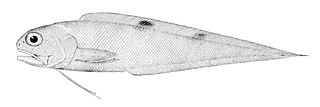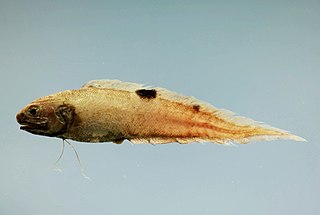
The cusk-eel family, Ophidiidae, is a group of marine boney fishes in the order Ophidiiformes. The scientific name is from the Greek ophis meaning "snake", and refers to their eel-like appearance. True eels, however, diverged from other ray-finned fish during the Jurassic, while cusk-eels are part of the Percomorpha clade, along with tuna, perch, seahorses, and others. Unlike true eels of the order Anguilliformes, cusk-eels have ventral fins that are developed into a forked barbel-like organ below the mouth. In the true eels by contrast, the ventral fins are never well-developed and usually missing entirely.

Coryphaenoides is a genus of rattails which is found in all oceans of the world. They are found in deep waters and C. yaquinae, recorded to 7,012 m (23,005 ft), is the only member in the family known from the hadal zone.
Bathycongrus is a genus of eels in the family Congridae.

Lophiodes is a genus of goosefishes. It is one of four extant genera in the family Lophiidae.
Sciadonus is a genus of blind cusk eels.
Bellottia is a genus of viviparous brotulas which is found in the subtropical waters of the North Atlantic, the Mediterranean Sea and the Indo-Pacific.
Diplacanthopoma is a genus of viviparous brotulas.

Hephthocara is a small genus of Indo-Pacific viviparous brotula.
Pyramodon is a genus of pearlfishes, with these currently recognized species:
Barathrodemus is a genus of cusk-eels found in deep waters.
Bassozetus is a genus of cusk-eels found in Atlantic, Indian and Pacific Ocean.
Bathyonus is a genus of cusk-eels.
Enchelybrotula is a genus of deep-water cusk-eels.
Glyptophidium is a genus of cusk-eels.

Holcomycteronus is a genus of cusk-eels. It includes Holcomycteronus profundissimus, long thought to be the deepest-living fish in the world's oceans.
Luciobrotula is a genus of cusk-eels.

Monomitopus is a genus of cusk-eels. They are oviparous.

Neobythites is a genus of cusk-eels.
Porogadus is a genus of cusk-eels.

Neobythitinae is a subfamily of cusk eel from the family Ophidiidae. They are mostly fishes of deeper waters, occurring from the continental shelf down to as deep as 8,370 metres (27,460 ft) at the bottom of the Puerto Rico trench where the deepest known fish, Abyssobrotula galatheae, has been taken.








